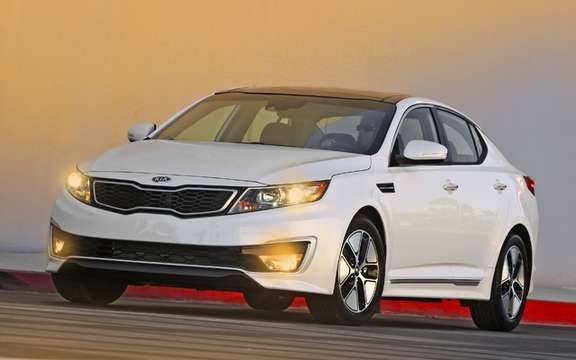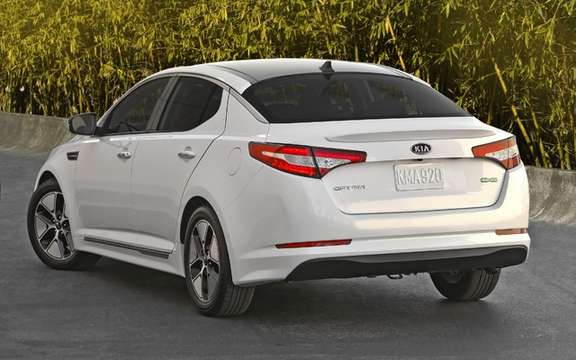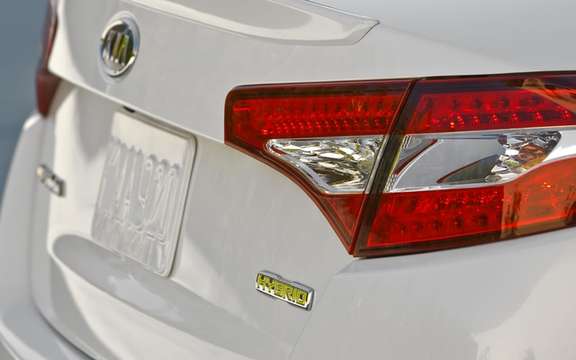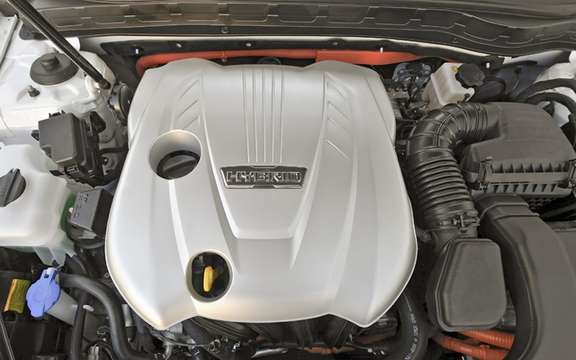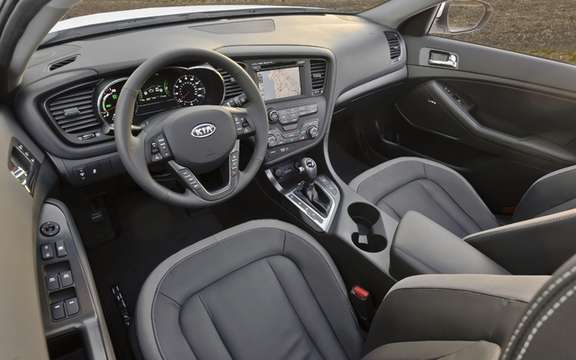Kia Optima Hybrid: A lithium-polymer
The 2011 Kia Optima Hybrid will offer a mix of technology, efficiency and design
- The new Optima uses a lithium-polymer more efficient feed
- The addition of a hybrid model continues the dramatic transformation of Kia
As a new model transformation Kia focused on the design, the all-new 2011 Optima midsize sedan offers a hybrid version, a world first for Kia Motors America (KMA) According to the Los Angeles Auto Show. Featuring stunning lines, a spacious interior and an amazing energy efficiency, the first Kia hybrid road in North America attract people in search of a sleek and well equipped sedan that is no sacrifice in style, comfort, performance or value to realize energy efficiency. Expected in showrooms in 2011, the Optima Hybrid is powered by a powertrain developed by Kia that displays several innovations to provide exceptional hybrid performance and efficiency.
According to Maria Soklis, Chief Operating Officer at Kia Canada Inc. "The launch of the Optima Hybrid in the Canadian market in 2011 represents an important milestone for Kia as part of its transformation-based design with improvements Class global level of technology. In addition, the hybrid enhances our reputation even more responsible carmaker continues to provide Canadians with efficient vehicles global category and bonuses at conception. "
The 2011 Optima Hybrid uses a parallel hybrid system allowing it to roll without transmission and / or fuel-electric mixed mode. If, when the vehicle makes a stop, the electric demand is low, the engine fuel cut completely to eliminate fuel consumption and emission.
Lithium-polymer battery sustainable
Superb efficiency of the 2011 Optima Hybrid comes largely from its lithium-polymer battery developed in South Korea with partner LG Chem. The power and energy density of the battery enabled Kia engineers to create a lighter and more compact battery providing 30 kilowatts has a weight of 43.6 kg - 1.7 kg less than the nickel-hydride battery metal of the 2011 Toyota Camry - thus promoting fuel economy and helping to maximize storage space in the trunk.
The battery Optima Hybrid retains its charge up to 25 percent longer than the nickel-metal hydride. It should therefore be a useful energy even if it has not been used. Fuel consumption and emissions are reduced allowing more of departures by starting and electrical energy. Thanks to this superior efficiency, greater part of the kinetic energy and charging energy recovered from the engine is available to move the vehicle, allowing electric propulsion method more often and for longer periods loins. The lithium-polymer possesses the characteristics of self-discharge lower than most rechargeable batteries.
Unique hybrid architecture of its kind
Unlike most systems on the market, the powertrain of the Optima Hybrid features a unique architecture of its kind. Compared to a hybrid system Shared power found on vehicles Toyota or Ford, the Optima Hybrid uses a electric drive mounted on the gearbox (or MTBF) or the electric motor is separated from the gear train of the gearbox. This modular Layouts offers several advantages such as more efficient powertrain, the use of standard components such as automatic transmission has six reports Optima 2.4L GDI and a reduced investment in engineering. This also allows other future combinations as the application of more powerful motors and higher capacity batteries.
The Optima Hybrid also is among one of the first fully hybrid systems to use an automatic box of standard reports. The box has six extremely compact reports which debuted on the 2011 Kia Sorento CUV, is used virtually unchanged. An external electric oil pump has also been added to provide the hydraulic pressure required to keep the clutches engaged when the vehicle is in idle stop mode.
The electric motor of the Optima Hybrid is mechanically connected to the shaft and fitted with a synchronous electric traction motor with permanent magnets developping 40.2 HP (30 kW) and a torque of 151.2 lb-ft in electric-only mode and , hybrid mode, 206.2 HP has a couple of 195.4 lb-ft - impressive. It also replaces the torque converter has a multiple disc clutch between the electric motor and petrol engine to a latter to disengage powertrain modes for idle stop and electric drive. This arrangement allows the entire group, including a torsion damper, to occupy the same space as a regular torque converter.
Another unique component of the Optima Hybrid is a hybrid starter-generator's (or HSG). The starter-generator is 8.5 kilowatts connects Theta II engine belt and operates at the same voltage of 270 volts as the electric traction motor and the lithium polymer battery, but cause a tensile stress on the vehicle . Rather, the HSG comes into play to start the engine petrol and charge the hybrid battery.
One of the main advantages of electric hybrid powertrain lies in its ability to recover the energy lost during braking and store it for use during acceleration and cruising speed conduct. When you press the brake pedal, the engine gasoline disengages the traction motor, causing no friction effect. The electric motor functions as generator to recharge the hybrid battery. Convert kinetic energy into electrical energy rather than thermal energy through the friction brakes also reduces the wear of the brake pads thus last longer. During an emergency stop or driving downhill, increased reliability regenerative braking allows for the brakes to be more effective.
The Optima Hybrid uses a braking system electronic control which establishes requirements dependent braking force applied to the brake pedal which is converted to a total brake torque. The hybrid system control then detects the level of battery charge, vehicle speed and other conditions to calculate the level of regenerative braking required. The control system then receives the maximum braking force regenerative braking to control the braking torque by friction so that total net torque is equal to the driver's needs.
Like all 2011 Optima, the hybrid version uses a power steering by a electric motor (or EPAS) that provides instant strength and amplified only when it is required during operations. Reduced weight compared to that of a power-assisted hydraulic steering motor, the EPAS is independent of the petrol engine and assists even when it does not work, as in idle stop mode or electric drive.
The Optima Hybrid also displays a compressor drive electric air conditioner that keeps the air conditioning when the engine fuel cut. As management has electric drive, the air conditioner compressor has electric drive provides more precise control on demand, reducing the load on the powertrain and reduces fuel consumption.
Enjoying the instantantee and continuous availability of torque electric motor, Kia engineers have modified the engine Theta II 2.4L popular for it follows the Atkinson cycle, raising the compression ratio of 20 percent to maximize its efficiency and realize a fuel economy of 10 percent compared to standard Theta engine. This cycle generates a slightly lower torque, but the electric motor compensates for any loss and, therefore, the power and torque of the general Optima Hybrid are superior to that of the petrol model without turbocharger.
The lightness of the Optima contributes to its high performance as well as its superb energy efficiency. The architecture of the new platform slight Optima, combined with the lightweight lithium-polymer, carries the weight of the Optima Hybrid has just 1,586 pounds, 104.5 pounds less than the hybrid Ford Fusio 2011.
Besides the innovative powertrain Optima Hybrid, Kia's engineers have all aspects of efficiency, including aerodynamics and rolling resistance. The Optima Hybrid offers aerodynamic refinements on the outside, a reduced ride height, a system of flaps active air, underbody which reduces friction and tires with low rolling resistance that help improve the effectiveness. The coefficient of friction of the Optima Hybrid is exceptionally weak to 0.26
The high efficiency powertrain, tires with low rolling resistance and aerodynamic pure lines of the Optima hybrid result in energy efficiency while-a-exceptional.
View the gallery
